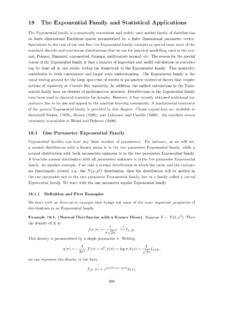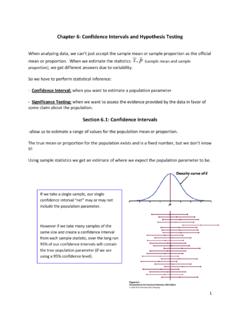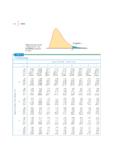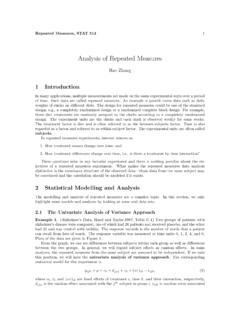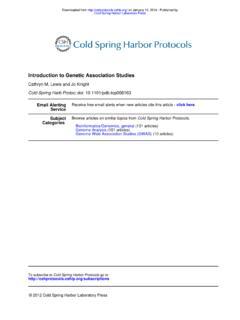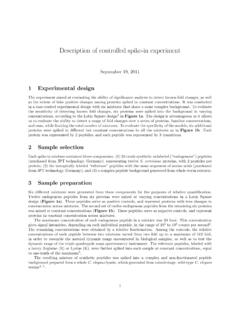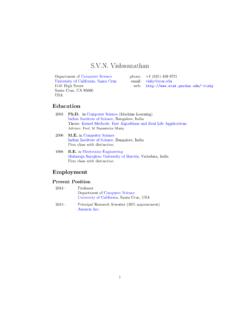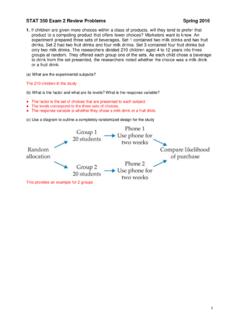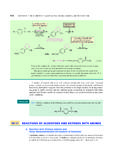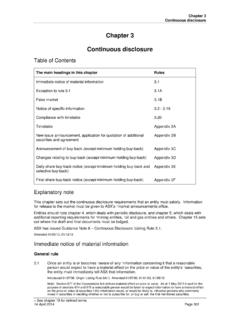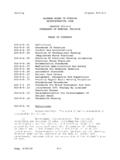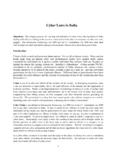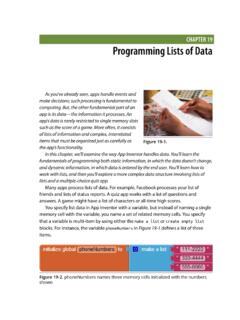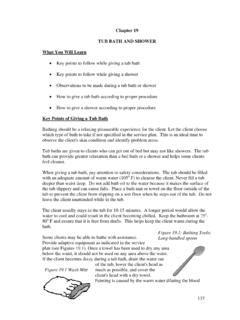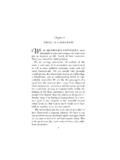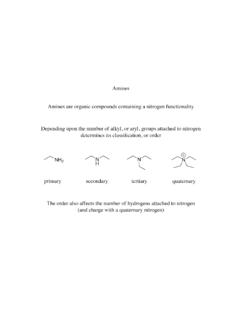Transcription of Chapter 19 Split-Plot Designs - Department of …
1 Chapter 19 Split-Plot DesignsSplit- plot Designs are needed when the levels of some treatmentfactors are more difficult to change during the experiment thanthose of others. The Designs have a nested blocking structure: split plots are nested within whole plots, which may be nestedwithin An experiment is to compare the yield of threevarieties of oats (factor A with a=3 levels) and four differentlevels of manure (factor B with b=4 levels). Suppose 6 farmersagree to participate in the experiment and each will designate afarm field for the experiment (blocking factor with s=6 levels).Since it is easier to plant a variety of oat in a large field, theexperimenter uses a Split-Plot design as divide each block into three equal sized plots (wholeplots), and each plot is assigned a variety of oat accordingto a randomized block design .
2 Whole plot is divided into 4 plots ( split -plots) and thefour levels of manure are randomly assigned to the 4 model for such a Split-Plot design is the following:where , and are mutuallyindependent, h=1, 2, .., s, i=1, 2, .., a, j=1, 2, .., the nested blocking structure: whole plots are nestedwithin the blocks, and split -plots are nested within the kinds of errors: representing the random effects of thewhole plots, and representing the random effects of split -plots and random Table for Split-Plot Designs :Source VariationBlocks-1SS Aa-1 SSAMSAMSA/MSEwWhole- plot error (s-1)(a-1) SSEwMSEwBb-1 SSBMSBMSB/MSEsAB(a-1)(b-1) SSABMSABMSAB/MSEsSplit- plot errora(b-1)(s-1) SSEsMSEsTotaln-1 SstotalFor calculations of the sums of squares, please see table onpage for testing of equal effects of factor A, the whole-plotmean square error is used.
3 It should also be used for main effectcontrasts of factor A. For tests or main effect contrasts of factorB, or AB interaction contrasts, the Split-Plot mean square erroris main effects and interaction contrasts, the methods ofmultiple comparison of Bonferroni, Scheffe, Tukey, Dunnett,and Hsu can be used as : If either levels of factor are assigned to whole plots asan incomplete block design , or the levels of factor B areassigned to split -plots as an incomplete design , the formulas ofthe sum of squares should be adjusted. But the degrees offreedom will remain the same. Estimates for main effects andinteraction contrasts should be adjusted general, within-whole- plot comparisons will generally bemore precise than between-whole- plot comparisons.
4 If the levelsof all factors are easy to change, Split-Plot Designs arerecommended only when there is considerably less interest inone or more of the treatment Programs1. Complete block Designs ** analysis of variance; * method 1;PROC GLM; CLASSES BLOCK A B WP; MODEL Y = BLOCK A WP(BLOCK) B A*B/E1; RANDOM BLOCK WP(BLOCK) /TEST; MEANS A / DUNNETT('0') ALPHA= CLDIFF E=WP(BLOCK); MEANS B / DUNNETT('0') ALPHA= CLDIFF;RUN;2. Complete block Designs or incomplete block Designs ** analysis of variance; * method 2;PROC GLM; CLASSES BLOCK A B; MODEL Y = BLOCK A BLOCK*A B A*B; RANDOM BLOCK A*BLOCK/TEST; MEANS A / DUNNETT('0') ALPHA= CLDIFF E=BLOCK*A; MEANS B / DUNNETT('0') ALPHA= CLDIFF;Run;Note the second method does not use the whole- plot as arandom factor as in methods one.
5 It makes use of the fact thatthe whole- plot error sum of squares uses the same degrees offreedom as the interactions between the block factor and thewhole- plot of Split-Plot design and Analysis: The Oats ExperimentAn experiment on the yield of three varieties (factor A) and four different levels of manure(factor B) was described by Yates (Complex Experiments, 1935). The experiment area wasdivided into s=6 blocks. Each of these was then subdivided into a=3 whole plots. The varieties ofoats were sown on the whole plots according to a randomized complete block design . Eachwhole plot was then divided into b=4 split -plots and the levels of manure were applied to thesplit plots according to a randomized complete block design .
6 The design and data were shown inTable , page Write down an appropriate model for this experiment. the varieties of oats and the levels of manure have significant interaction effects?3. Do the varieties of oats have significantly different effects?4. Do the levels of manure have significantly different effects?5. Find simultaneous 95% confidence intervals for all treatment-versus-control comparisons forthe varieties(Variety 0 is the control).6. Find simultaneous 95% confidence intervals for all treatment-versus-control comparisons forthe levels of manure (Level 0 is the control).SAS Program:** analysis of variance; * method 1;PROC GLM; CLASSES BLOCK A B WP; MODEL Y = BLOCK A WP(BLOCK) B A*B / E1; RANDOM BLOCK WP(BLOCK) / TEST; MEANS A / DUNNETT('0') ALPHA= CLDIFF E=WP(BLOCK); MEANS B / DUNNETT('0') ALPHA= CLDIFF;title 'method 1';;** analysis of variance; * method 2;DATA; SET OAT;PROC GLM; CLASSES BLOCK A B; MODEL Y = BLOCK A BLOCK*A B A*B; RANDOM BLOCK A*BLOCK/TEST; LSMEANS A / PDIFF=CONTROL CL ADJUST=DUNNETT ALPHA= E=BLOCK*A; LSMEANS B / PDIFF=CONTROL CL ADJUST=DUNNETT ALPHA= ;title 'Method 2';run;The two methods give identical results.
7 Result from method 1 is given in the book (p689).Provided below are results from method 2. General Linear Models ProcedureDependent Variable: Y Sum of MeanSource DF Squares Square F Value Pr > FModel 26 45 Total 71 R-Square Root MSE Y Mean DF Type I SS Mean Square F Value Pr > FBLOCK 5 2 *A 10 3 *B
8 6 DF Type III SS Mean Square F Value Pr > FBLOCK 5 2 *A 10 3 *B 6 General Linear Models ProcedureSource Type III Expected Mean SquareBLOCK Var(Error) + 4 Var(BLOCK*A) + 12 Var(BLOCK)A Var(Error) + 4 Var(BLOCK*A) + Q(A,A*B)BLOCK*A Var(Error) + 4 Var(BLOCK*A)B Var(Error) + Q(B,A*B)A*B Var(Error) + Q(A*B) Tests of Hypotheses for Mixed Model Analysis of VarianceDependent Variable: YSource: BLOCKE rror: MS(BLOCK*A) Denominator Denominator DF Type III MS DF MS F Value Pr > F 5 10 : A *Error: MS(BLOCK*A) Denominator Denominator DF Type III MS DF MS F Value Pr > F 2 10 * - This test assumes one or more other fixed effects are : BLOCK*AError.
9 MS(Error) Denominator Denominator DF Type III MS DF MS F Value Pr > F 10 45 : B *Error: MS(Error) Denominator Denominator DF Type III MS DF MS F Value Pr > F 3 45 * - This test assumes one or more other fixed effects are : A*BError: MS(Error) Denominator Denominator DF Type III MS DF MS F Value Pr > F 6 45 99% 99% Lower Upper Confidence Confidence A Limit Y LSMEAN Limit 0 1 2 Least Squares Means Adjustment for multiple comparisons.
10 Dunnett Least Squares Means for effect A 99% Confidence Limits for LSMEAN(i)-LSMEAN(j) Simultaneous Simultaneous Lower Difference Upper Confidence Between Confidence i j Limit Means Limit 2 1 3 1 Least Squares Means 99% 99% Lower Upper Confidence Confidence B Limit
